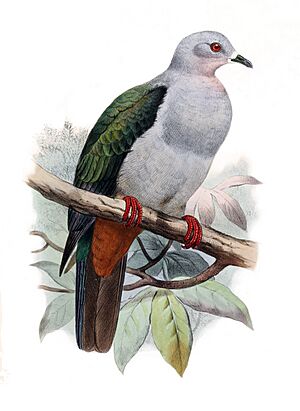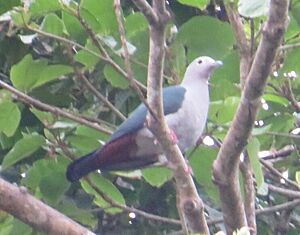Island imperial pigeon facts for kids
Quick facts for kids Island imperial pigeon |
|
|---|---|
 |
|
| Conservation status | |
| Scientific classification | |
| Genus: |
Ducula
|
| Species: |
pistrinaria
|
The island imperial pigeon or floury imperial pigeon (Ducula pistrinaria) is a cool type of bird that belongs to the Columbidae family, which includes all pigeons and doves. You can find this pigeon living in the Bismarck Archipelago and the Solomon Islands. It likes to live in different kinds of forests, including those near the coast and even in mangrove swamps. Good news! The International Union for Conservation of Nature (IUCN) says this bird is a "least-concern species," which means it's not currently in danger of disappearing.
Contents
About the Island Imperial Pigeon
Scientists gave this bird its official name, Ducula pistrinaria, back in 1855. It was named by a scientist named Charles Lucien Bonaparte. Just like how families have different members, some birds have slightly different groups called subspecies. For the island imperial pigeon, there are a few recognized subspecies, which are like different versions of the same bird found in various places.
What Does It Look Like?

The island imperial pigeon is a fairly big bird, usually about 39 to 45 centimeters (about 15 to 18 inches) long. It weighs around 470 to 500 grams (about 1 to 1.1 pounds), which is similar to a small melon!
Its head and neck are a light grey color, and it has cool white rings around its eyes, almost like it's wearing tiny glasses. The top part of its body, like its back and wings, looks shiny. Its wing feathers are grey-green, while the longer flight feathers are blackish. The back is also grey-green.
The tail feathers on top are a dark blue-green, but underneath, the tail is a warm chestnut brown. Its throat has a reddish-purple color, and its chest is a greyish-reddish-purple. The belly is a soft greyish-tan.
This pigeon has a blue-grey beak with a black tip. Its eyes are a dark red or brownish color, and its feet are red. Young pigeons look a bit duller and more yellowish-brown than the adults.
Where Does It Live and What's Its Home Like?
You can find the island imperial pigeon in the Bismarck Archipelago and the Solomon Islands archipelago. It also lives on some smaller islands north and east of New Guinea.
This bird loves coastal areas. Its favorite homes are in primary forests (which are old, untouched forests), old secondary forests (forests that have grown back after being cut down), and especially in mangrove swamps. It can also be found in some areas where humans have changed the habitat a bit.
How Does the Island Imperial Pigeon Behave?
You'll often see these pigeons alone or in pairs, but sometimes they gather in small groups. Every now and then, you might even spot a large flock flying together! They are very fast and direct flyers.
When it's time to eat, these pigeons are quite clever. They fly up into the tops of trees and pick fruits right off the branches. They also fly across the sea to find new places with food.
The island imperial pigeon has some interesting calls. One call sounds like a rising and repeated c-wooooohooo, which they make while standing tall. They also have a loud series of cooing sounds that go down in pitch, and they bob their heads up and down while making these calls. Another sound they make is a high-pitched crrrrrurrr.
When they want to show off or attract a mate, they perform a special display flight. They fly straight up into the air at a steep angle (about 70 degrees) and then glide back down.
Scientists have seen these birds building nests and laying eggs between June and September, and also in March. They build their nests at the very end of a tree branch using small twigs. Usually, they lay just one egg.
Is the Island Imperial Pigeon Safe?
Yes, the International Union for Conservation of Nature (IUCN) has listed the island imperial pigeon as a "least-concern species". This is good news! It means that the bird lives in a very wide area, and its population seems to be stable, so it's not currently at risk of becoming endangered.


